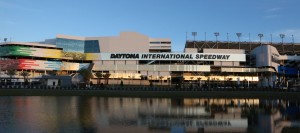Fox Gears Up for Daytona 500
Daytona International Speedway renovation will provide a new backdrop for the race
Story Highlights
Fans will have seen the iconic Daytona 500 race 57 times before they see the 58th on Sunday Feb. 21, but this will be the first time they’ll see it in what NASCAR hopes will become the template for its race venues. At the same time, Fox Sports has prepared an unprecedented accumulation of content — more than 100 hours — to be shown before, during, and after what will be a long weekend leading up to the main event (1 p.m. ET, with live coverage beginning at noon).

The $400 million Daytona Rising project yielded a massively extended grandstand.
This year’s Daytona Speedweeks marks the completion of the $400 million Daytona Rising redevelopment project. The massive, newly extended grandstand holds 101,500 new, wider seats; thousands of premium club seats; 40 escalators and 17 elevators; 60 luxury suites; 11 social “neighborhoods”; and three concourse levels that will span the nearly mile-long front stretch.
Fox Sports will be pushing envelopes of its own at this race. Among the innovations, an augmented-reality view of a virtual race car will be generated from the “Hollywood Hotel,” the suite of Game Creek FX mobile units that have been Fox’s partners on this show for nine years (and were so named by Darrel Waltrip). This will be done in conjunction with Stype’s camera-tracking hardware, software, and integration for real-time augmented reality and virtual-studio broadcasting and the Stype kit system for tracking the jib camera position in 3D space. This will enable putting immersive 3D graphics in the middle of the action and enabling a reporter to point out the features of a racecar using a virtual version of a cutaway car.
Deploying Vizrt technology, Fox Sports uses a high-tech touchscreen to provide magnified looks at the smallest details of the high-powered machines on the track, giving viewers a clear and illustrative explanation of how the car works and performs.
Two Inertia Unlimited Phantom Flex4K camera, capable of up to 1,000 fps and allowing tight slow-motion shots, are located on the front stretch and the beginning of the back stretch.
“These cameras will be able to replay and zoom into the action now as a high-frame-rate camera,” says Michael Davies, SVP, field and technical operations, Fox Sports. “With one camera, we can now break down a wreck in multiple ways using a single camera shot: zoom into the car that caused the wreck, the car that got caught up in it, and the one that got away.”
Inertia Unlimited’s Gopher Cam (aka the Ground Cam) returns for its eighth season of Fox’s NASCAR coverage, now with a new lens, a lower profile, and new track positions. At Daytona, four cameras will be placed in harm’s way, including one in Turn 4 and another on the backstretch, positioned so that cars run over the cameras at more than 200 mph.
Another returning favorite is the Gyro-Cam, a gyro-stabilized, in-car camera mounted in the center of the cockpit and rotating as cars enter the extreme 31-degree banked turns, keeping its view level with the horizon at all times. Two will be used at Daytona.
Much of this has been developed in the Fox Lab, the network’s “skunk works” that tests and adapts new platforms for sports broadcasting.
“Daytona is a good place to test technology because we have so much time there,” says Davies, citing the two full weeks and as many as six major races that can serve as petri dishes for new ideas. “We have great facilities there and lots of traffic. It’s the perfect field lab.”
Fox Sports’ Daytona Speedweeks coverage kicks off Friday on FS1 with NASCAR Sprint Cup Series Practice for the Sprint Unlimited (5 p.m.). The Sprint Unlimited, the first NASCAR event of the 2016 season, airs live on Fox on Saturday (8 p.m.).
In all, Fox Sports will deploy 20 manned cameras; four in-track ground cameras; two Inertia Unlimited X-Mos, one at the end of pit road, the other at the start/finish line; a 33-ft. Tower Cam; two grass cams; 10 robotic race cameras; three robotic Hollywood Hotel cameras; eight in-car packages, each featuring three camera angles; four wireless roving pit/garage crews; and 25 digital-video-replay devices with more than 110 channels of recording/playout.
For audio, each of the 43 cars and race teams will have discrete RF communication radios. In all, more than 150 microphones will be placed along the track and throughout Daytona International Speedway. A special audio-editing unit will be deployed solely for driver–to–crew-chief communication to play back live interaction as well as edited material.
Davies observes that the renovated track, which also has a new announce booth, will provide an excellent backdrop for all this technology. “Whenever you have a new venue you want to relay that, and this one looks beautiful. But,” he adds, “the most important thing will be keeping the competition out in front.”
